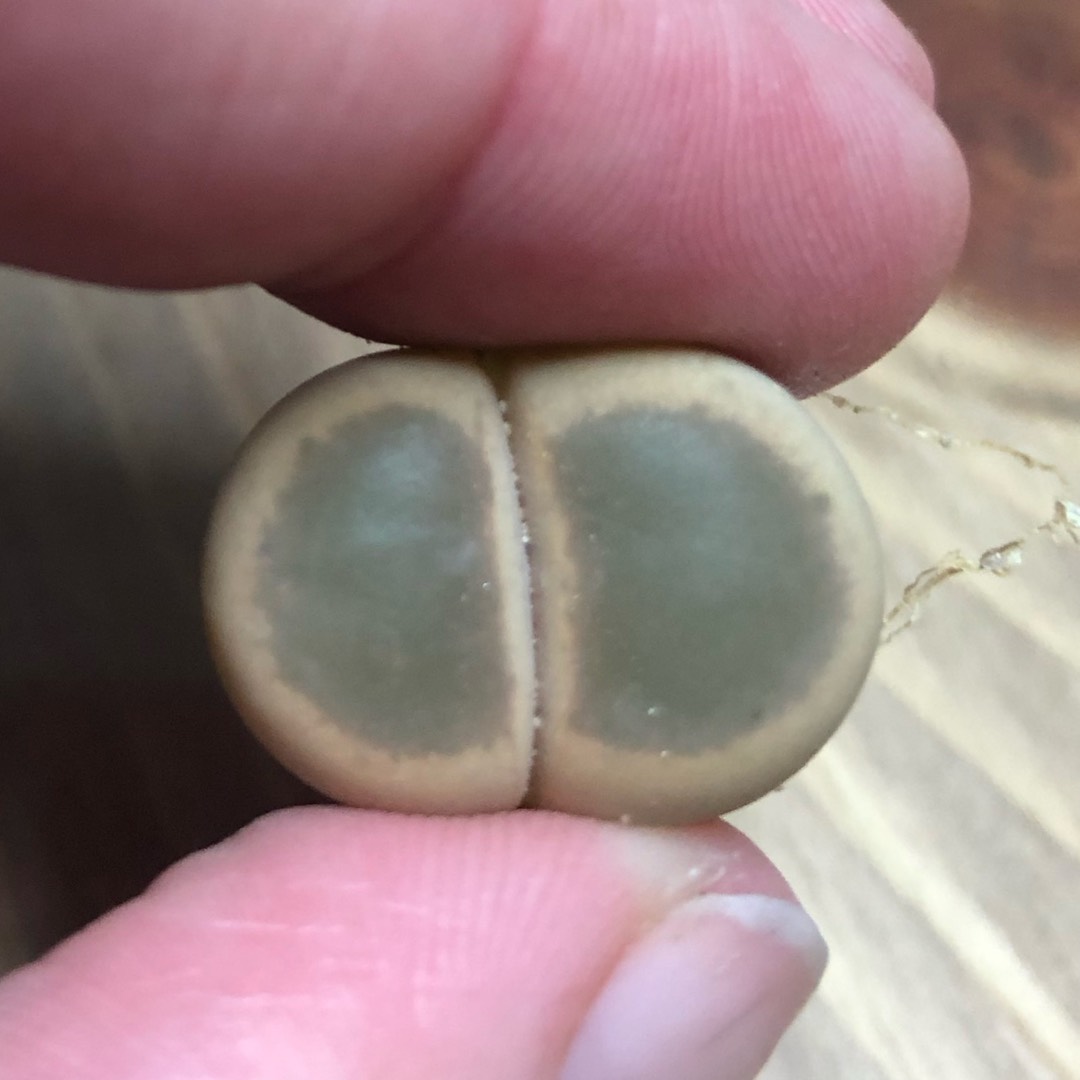
Lithops Dinteri var. Brevis
Living Stones 'Dinteri Brevis'
Original:Description: Lithops dinteri var. brevis is one of the local or morphological forms of the variable Lithops dinteri. The main point of difference between var. brevis and var. dinteri is that the red spots of the latter are bright red, 10-15, whereas those of var. brevis are fewer in number (1-5) dull red, more sparse, not so prominent and sometimes completely absent. Moreover var. brevis has a smoother appearance and has often a paler mustard colouration. It is however quite variable in colouration and the numbers and design of red dots on the tops of the leaves may vary a lot.Habit: This variety is more likely to form clumps, and with age especially if grown in shade, they tend to be slightly elongated, whatever we do.Bodies (paired leaves): Small sized, 12-20 mm long, 10-14 mm broad, turbinate; top of lobe flat; window large, open, transparent, very light-green, with a few round, elliptical blood-red lines near inner margin or blood-red markings absent; outer margin slightly sinuous or minutely serrate; inner margin straight; window bordered by a buff-coloured band, with many minute dots in the band. Flowers: Daisy-like, diurnal, yellow, small to medium, up to 32 mm across, mostly 20-25 mm across. Fruits: Capsules 4 or 5-chambered. Profile boat-shaped, top broadly elliptic, with hinge-rim flat, occasionaly slightly peaked.Seeds: Very fine, brown, tuberculate. New:A popular and sought after succulent. Lithops have paired leaves with smooth flat or rounded tops that are ridged or wrinkled, sometimes with transparent windows, and sometimes colorful markings. The flowers are white or yellow and emerge in autumn or winter. Lithops are relatively easy to grow if given sufficient sun and a suitable well-drained soil.
-
Full sun to partial shade
-
Very little water
-
Not Frost hardy
-
Light and free draining
Common name
Living Stones 'Dinteri Brevis'
Latin name
Lithops Dinteri var. Brevis
type
Succulent
family
Aizoaceae
ph
5.0 - 6.5 Acid - Neutral
Plant & bloom calendar
-
Best time to plant
full grown dimensions
 0.02 M
0.01 M
0.02 M
0.01 M
Lithops Dinteri var. Brevis
Original:Description: Lithops dinteri var. brevis is one of the local or morphological forms of the variable Lithops dinteri. The main point of difference between var. brevis and var. dinteri is that the red spots of the latter are bright red, 10-15, whereas those of var. brevis are fewer in number (1-5) dull red, more sparse, not so prominent and sometimes completely absent. Moreover var. brevis has a smoother appearance and has often a paler mustard colouration. It is however quite variable in colouration and the numbers and design of red dots on the tops of the leaves may vary a lot.Habit: This variety is more likely to form clumps, and with age especially if grown in shade, they tend to be slightly elongated, whatever we do.Bodies (paired leaves): Small sized, 12-20 mm long, 10-14 mm broad, turbinate; top of lobe flat; window large, open, transparent, very light-green, with a few round, elliptical blood-red lines near inner margin or blood-red markings absent; outer margin slightly sinuous or minutely serrate; inner margin straight; window bordered by a buff-coloured band, with many minute dots in the band. Flowers: Daisy-like, diurnal, yellow, small to medium, up to 32 mm across, mostly 20-25 mm across. Fruits: Capsules 4 or 5-chambered. Profile boat-shaped, top broadly elliptic, with hinge-rim flat, occasionaly slightly peaked.Seeds: Very fine, brown, tuberculate. New:A popular and sought after succulent. Lithops have paired leaves with smooth flat or rounded tops that are ridged or wrinkled, sometimes with transparent windows, and sometimes colorful markings. The flowers are white or yellow and emerge in autumn or winter. Lithops are relatively easy to grow if given sufficient sun and a suitable well-drained soil.
Planting
From Early Spring TO Early Spring
Lithops thrive best in a coarse, well-drained substrate. Any soil that retains too much water will cause the plants to burst their skins as they over-expand. Plants grown in strong light will develop hard strongly coloured skins which are resistant to damage and rot, although persistent overwatering will still be fatal. Excessive heat will kill potted plants as they cannot cool themselves by transpiration and rely on staying buried in cool soil below the surface.
Propagation
From Early Spring TO Early Spring
Propagation of Lithops is by seed or cuttings. Cuttings can only be used to produce new plants after a plant has naturally divided to form multiple heads, so most propagation is by seed. Lithops can readily be pollinated by hand if two separate clones of a species flower at the same time, and seed will be ripe about 9 months later. Seed is easy to germinate, but the seedlings are small and vulnerable for the first year or two, and will not flower until at least two or three years old.








